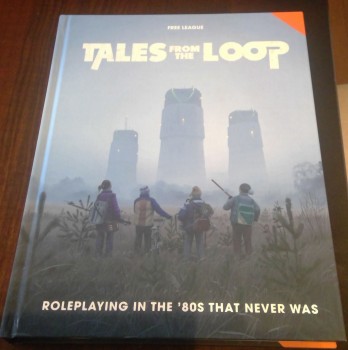Modular: Trouble in the ’80’s with Tales from the Loop
 As a child of the ’80’s, I grew up with the understanding that a group of kids might stumble upon a series of mysterious events and have to band together to deal with the challenges from it. Parents, law enforcement, and other authorities would be of no help, so there was no point in telling them what was going on. They either wouldn’t believe it or, worse, would stop the kids from fixing things. The kids, through determination and luck, were the only hope to set things right … whether it was finding a way to keep their families from being evicted, returning a strange visitor to another planet, or stopping rampaging monsters. Or, heck, even just making it through a day of detention.
As a child of the ’80’s, I grew up with the understanding that a group of kids might stumble upon a series of mysterious events and have to band together to deal with the challenges from it. Parents, law enforcement, and other authorities would be of no help, so there was no point in telling them what was going on. They either wouldn’t believe it or, worse, would stop the kids from fixing things. The kids, through determination and luck, were the only hope to set things right … whether it was finding a way to keep their families from being evicted, returning a strange visitor to another planet, or stopping rampaging monsters. Or, heck, even just making it through a day of detention.
E.T., The Goonies, Stand By Me, The Breakfast Club, Flight of the Navigator, The Last Starfighter, Lost Boys, SpaceCamp, Gremlins. These are the types of films, along with more recent period pieces like The Iron Giant and Stranger Things, and maybe a touch of the SyFy Channel’s television series Eureka thrown in, that inspire the science fiction role-playing game Tales from the Loop from Modiphius Entertainment.
Tales from the Loop centers around a community in the 1980’s that is home to a research center and particle accelerator, called “The Loop.” There are actually two settings outlined in the book: the Swedish island of Svartsjolandet or the American town Boulder City. Whichever community your characters live in, you play a group of Kids who come into contact with a Mystery related to the particle accelerator, and join together to resolve the Mystery. The game can be extremely episodic, great for a standalone one-shot game, or played in a more “sandbox” format where the players are able to explore the setting in more depth, allowing for a more long-term campaign.
The Characters
The player characters in this game are all Kids, ages 10 to 15, that each are built on one of the following types:
- Bookworm
- Computer Geek
- Hick
- Jock
- Popular Kid
- Rocker
- Troublemaker
- Weirdo
The stats are pretty basic. Four attributes – Body, Tech, Heart, and Mind – are determined and, together with Skills like Move, Charm, and Tinker, are used to determine the number of 6-sided dice you roll when needed. It’s a very minimalist system in terms of mechanics, focusing more on a narrative play.
One nice feature is that there’s a balance between younger/older characters. You get a number of attribute points based on your age, but you get a number of “Luck Points” (which grant rerolls of all failed dice) based on 15 minus your age. So while the older kids have slightly more developed attributes, younger kids have a good chance of still succeeding when it matters most.
You get to pick one Iconic Item that your character always has access to, which can be anything. Some examples given in the book are: magnifying glass, pets, toy lightsaber, computer, pocket calculator, crowbar, knife, skateboard, baseball bat, boombox, or drawing pad. An Iconic Item gives +2 dice anytime it can be used to help with the check. So, for example, a character with a skateboard gets a +2 on Body & Move checks to escape someone chasing them (a la Back to the Future). Characters can also acquire and build items that are helpful (a +1 to +3 bonus, depending on the situation), but only the Iconic Item is kept by the character from session to session.
Mostly, though, the character generation process focuses on narrative elements. Each character has a Problem in their personal life, which can be anything from being bullied at school (or home) to unrequited love to parents who are always arguing and about to get a divorce. The character’s Drive explains why they are motivated to get into danger to pursue the Mystery, such as curiosity, boredom, or greed, while the Pride represents something about the Kid that they fundamentally value and appreciate about themself, such as their intellect, popularity, or musical ability.
Next, each character writes a sentence about their relationships to the other kids, and to two NPCs that are key to their character (usually, but not always, family members or people at school). They also identify one person who is their Anchor, which comes into play when they need to recover from damage they’ve taken in the game.
The last step in the character creation is to pick the kids’ favorite song. An ’80’s song, one would assume … although I suppose a kid could be an Elvis fan or into classical music.
Modiphius Entertainment is also the publisher of the Star Trek Adventures RPG that I have reviewed in the past during it’s open playtest. (Now that it’s out, trust me, I’ll get to another review of it.) Star Trek Adventures also has a character creation process that has the benefit of really making you think deeply about your character’s background and values, and provides a variety of ways that those decisions inform the gameplay directly. I’m curious to look into more of Modiphius’ games, to see if this emphasis on these narrative elements is a common theme through the rest of their products. But both of these creation systems really provide fodder for stories that matter to the characters and, hopefully, to the players.
Game Play
The game begins with each kid having a scene of their “Everyday Life,” which sets the stage for the normal world before the chaos of the Mystery begins. This doesn’t mean that things are going smoothly. The opening Everyday Life scene may involve a bully, or waking up late to discover the electricity has been shut off, or some other incident related to the Kids’ Problem.
As the scenes progress, the Kids uncover the Mystery and begin investigating it, with the players given a lot of control about how the scenes unfold. Eventually, though, the Kids will run into Trouble … and that’s when they have to make a roll. They decide how they want to deal with the Trouble, and they work out with the Gamemaster the appropriate Attribute and Skill to roll. They roll that number of 6-sided dice, and each 6 rolled counts as a success. In most cases, the Trouble is overcome if the Kid gets a single success … although in really bad situations, it can go up to three, and the Mystery’s climax can require a number of accumulated successes from the whole group.
One of the rules of the game is that the Kids cannot die. When they fail to overcome Trouble, they suffer “Conditions” like being Upset, Exhausted, Scared, Injured, and (if they’re already all of those things) Broken. Most Conditions result in a dice penalty to Trouble checks, but being Broken means they automatically fail any roll they have to make. Recovering from Conditions involves spending a scene with their Anchor.
Much of the book is taken up with a description of the setting, and of some ideas about way to structure the session and Mysteries, to balance the scientific curiosity with the Everyday Life elements of the story, and how to create dramatic scenes where Trouble intrudes on Everyday Life. There’s a “Mystery Landscape” chapter that provides details for a more “sandbox” approach to the game, and a structured four-Mystery sequence that can be used as a campaign.
Overall, I’d say that Tales from the Loop is one of the more original and entertaining new RPGs that I’ve encountered. And the fact that they won 5 ENnies at GenCon 2017, including Best Game and Product of the Year, means I’m not alone in this assessment. Though not based directly on an established franchise, it draws richly from elements of popular culture that will make it resonate with many players. The focus on narrative play also means it’s a good game for people who aren’t necessarily big into learning a ton of new rules.
There’s already a supplement out, the campaign book Our Friends the Machines & Other Mysteries. Given the high quality of the core rulebook, I’m definitely looking forward to seeing what they have to offer as they expand into additional products, and how the possibilities of this games are realized.
Other Links
- Buy Tales from the Loop on Amazon.com
- Buy Tales from the Loop on DriveThruRPG
- Buy Tales from the Loop on Modiphius Entertainment
- Tales from the Loop RPG trailer
Disclaimer: A complimentary review copy of the game was provided by the publisher for the purposes of this review.

This game looks like it could be a real blast. Whether as an 80’s child (me as well) or even as an intro for children as it seems really kid friendly. A recent movie that would also fir the mould would be 8 millimetre I think, although technical seventies as I recall.
Thanks for the walk down memory lane Andrew. Now I need to go and re watch some of those movies.
Two other indy RPGs in the same vein to check out is vs Stranger Stuff by Fat Goblin Games and Dark Places & Demogorgons by Bloat Games.
You can get a stripped-down version of vs. Stranger Stuff as a free download and Dark Places & Demogorgons is currently half-price at DriveThruRPG.
John – Yeah, that’s a good one in this “genre.” Iron Giant isn’t set in the ’80’s either (McCarthy’s 1950’s, as I recall) and I think feels much the same … although I also think it’s a solo kid instead of a group.
It definitely triggered my nostalgia reflex. After I finished the post, I went out to the library and picked up a copy of The Last Starfighter, which I have seen maybe once since it was in the theater.